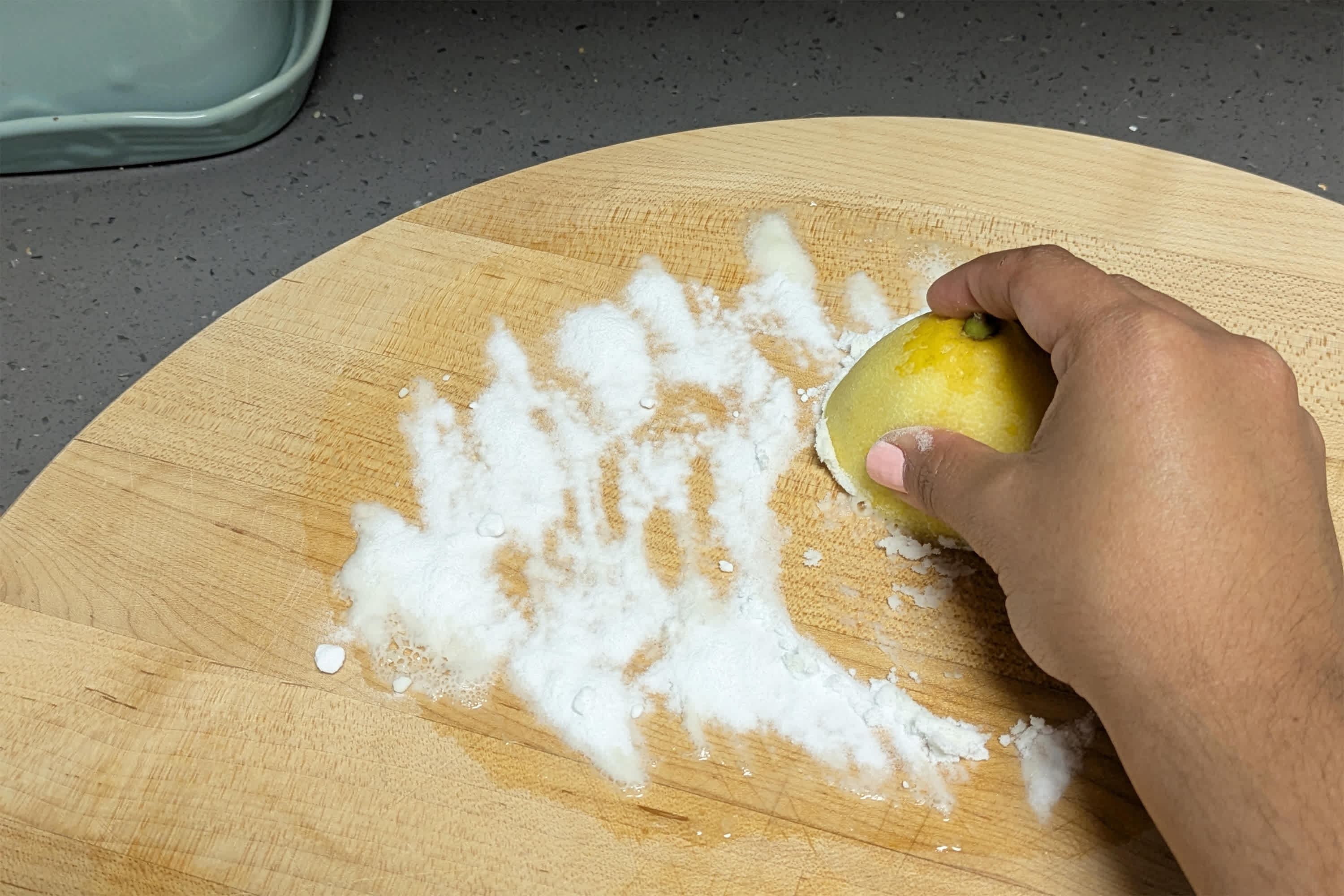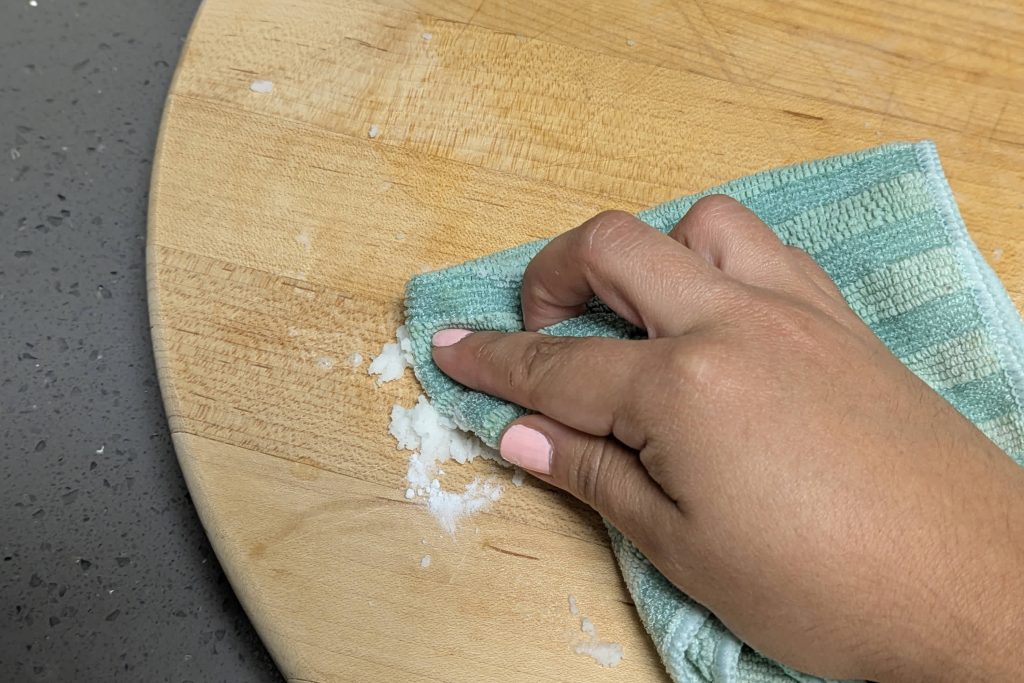Your wooden cutting board is more than just a kitchen tool—it’s where you prepare the meals that fuel your day. But do you know the best way to clean it without damaging the wood or leaving harmful bacteria behind?
If you want to keep your board safe, fresh, and long-lasting, this guide is exactly what you need. Read on to discover simple, effective cleaning tips that will protect your cutting board and make your cooking safer and more enjoyable.

Credit: www.thekitchn.com
Daily Cleaning Tips
Cleaning a wooden cutting board every day keeps it safe and lasts longer. Dirt and germs can hide in the wood if not cleaned well.
Use simple steps to wash and dry your board after each use. This stops bacteria and keeps your board looking good.
Rinsing And Soap Wash
Start by rinsing your wooden cutting board with warm water. This removes food bits and loose dirt.
Next, use mild dish soap and a soft sponge. Gently scrub the board on all sides.
- Use warm water, not hot, to avoid warping the wood.
- Do not soak the board in water for long times.
- Rinse the soap off completely to avoid residue.
- Clean both sides of the board to prevent warping.
Drying Properly
Dry your wooden cutting board right after washing. This stops water damage and mold growth.
| Drying Method | Details |
|---|---|
| Air Dry | Place board upright or on a rack for air flow on all sides. |
| Towel Dry | Use a clean towel to wipe off excess water before air drying. |
| Avoid | Do not leave the board flat on a wet surface or in direct sunlight. |

Credit: homewithgraceandjoy.com
Removing Stains And Odors
Wooden cutting boards can absorb stains and smells from food. Cleaning them properly keeps them fresh and safe to use. Natural ingredients work well to remove these issues.
Using simple items like lemon, salt, and baking soda can help clean your board without damage. These methods are easy and eco-friendly.
Using Lemon And Salt
Lemon and salt act as natural cleaners to remove stains and odors from wooden boards. The acid in lemon breaks down stains, while salt scrubs the surface gently.
- Cut a lemon in half.
- Sprinkle coarse salt over the stained area.
- Rub the lemon half on the salt and board, squeezing juice as you scrub.
- Let it sit for 5 minutes.
- Rinse with warm water and dry completely.
Baking Soda Paste
Baking soda paste is another great way to clean stains and remove smells. It works by lifting dirt and neutralizing odors.
| Ingredient | Amount |
| Baking soda | 2 tablespoons |
| Water | 1 tablespoon |
Mix baking soda and water to form a thick paste. Spread it over the board’s surface and let it sit for 10 minutes. Scrub gently with a soft brush or sponge, then rinse and dry.
Deep Cleaning Methods
Wooden cutting boards need deep cleaning to remove germs and stains. Regular washing is not enough to keep them safe and fresh. Using natural solutions can help clean and disinfect your board.
This guide covers two effective methods using vinegar and hydrogen peroxide. Both are easy to use and safe for wood.
Vinegar Solution
Vinegar is a natural disinfectant that kills bacteria on wooden boards. It also helps remove odors and light stains.
- Pour white vinegar directly onto the cutting board surface.
- Spread it evenly with a clean cloth or sponge.
- Let the vinegar sit for five to ten minutes to kill germs.
- Rinse the board with warm water after treatment.
- Dry the board completely with a clean towel or air dry.
Hydrogen Peroxide Treatment
Hydrogen peroxide is a strong cleaner that removes tough stains and kills bacteria. It works well on wooden cutting boards but should be used carefully.
| Step | Action | Notes |
|---|---|---|
| 1 | Pour 3% hydrogen peroxide over the cutting board. | Use enough to cover the surface. |
| 2 | Let it sit for 10 minutes. | Do not rinse immediately. |
| 3 | Scrub gently with a soft brush or sponge. | Avoid harsh scrubbing that may damage wood. |
| 4 | Rinse thoroughly with warm water. | Remove all peroxide residue. |
| 5 | Dry completely before storing. | Prevent wood warping and cracking. |

Credit: food52.com
Sanitizing The Board
Cleaning a wooden cutting board is important to keep it safe. Sanitizing kills germs and bacteria on the surface.
There are different ways to sanitize a wooden board. Two common ways are using a bleach solution and steam cleaning.
Bleach Solution Use
A bleach solution helps kill many types of bacteria on wooden boards. It is strong but should be used carefully.
Mix one tablespoon of bleach with one gallon of water. Use this solution to wipe the board well.
- Apply the bleach solution with a clean cloth or sponge
- Let it sit for a few minutes to kill bacteria
- Rinse the board with clean water after sanitizing
- Dry the board completely before storing
Steam Cleaning
Steam cleaning uses hot steam to kill germs without chemicals. It is safe for wooden boards if done correctly.
Use a steam cleaner or a pot with boiling water and steam the board surface. This method kills bacteria and cleans the board.
- Hold the board over the steam for several minutes
- Move the board to clean all areas with steam
- Let the board air dry after steam cleaning
Maintaining And Conditioning
Cleaning a wooden cutting board is important to keep it safe and strong. Proper maintenance helps stop cracks and warping.
Conditioning the wood keeps it smooth and stops it from drying out. This makes your board last longer and look better.
Applying Mineral Oil
Mineral oil protects wood by soaking into the surface. It keeps the wood from drying and cracking.
Use food-grade mineral oil for safety. Apply a small amount with a clean cloth and rub it all over the board.
- Apply oil evenly on all sides
- Let the oil soak for at least 4 hours
- Wipe off any extra oil with a dry cloth
- Repeat once a month or when the wood looks dry
Using Beeswax
Beeswax adds a protective layer on the board. It seals in moisture and makes the surface smooth.
Mix beeswax with mineral oil for easy use. Warm the mix slightly and rub it on the board with a soft cloth.
- Use a small amount of beeswax and oil blend
- Cover the entire board surface evenly
- Let it sit for a few hours to harden
- Buff the board with a clean cloth to shine
Avoiding Common Mistakes
Cleaning a wooden cutting board needs care. Mistakes can damage the wood and cause bacteria to grow. Knowing what to avoid helps keep your board safe and long-lasting.
This guide covers two common errors: soaking the board and using dishwashers. Avoid these to protect your wooden cutting board.
No Soaking
Do not soak your wooden cutting board in water. Wood absorbs water and can swell or crack. Soaking also weakens the glue that holds the board together.
- Use a damp cloth or sponge for cleaning.
- Rinse the board quickly with warm water after use.
- Dry the board immediately with a clean towel.
- Stand the board upright to air dry fully.
Avoiding Dishwashers
Never put a wooden cutting board in the dishwasher. The heat and water pressure can cause warping and cracking. It also removes natural oils from the wood.
| Dishwasher Effect | Impact on Board |
| High heat | Causes warping and cracks |
| Strong water jets | Removes natural oils |
| Long wash cycles | Leads to swelling and splitting |
Frequently Asked Questions
How Often Should You Clean A Wooden Cutting Board?
Clean your wooden cutting board after each use to prevent bacteria buildup. Use hot water and mild dish soap. Regular cleaning ensures food safety and prolongs the board’s lifespan. For deeper cleaning, occasionally apply white vinegar or baking soda. Avoid soaking the board to prevent warping.
Can You Use Bleach On A Wooden Cutting Board?
Avoid using bleach on wooden cutting boards. Bleach can damage the wood and leave harmful residues. Instead, use natural disinfectants like white vinegar or hydrogen peroxide. These options effectively kill bacteria without harming the wood. Remember, proper drying is crucial to maintain the board’s quality and safety.
How Do You Remove Stains From The Board?
To remove stains, sprinkle coarse salt or baking soda on the board. Rub with a halved lemon, squeezing gently to release the juice. Let it sit for a few minutes, then rinse with warm water. This method naturally lifts stains and deodorizes the board, keeping it fresh and clean.
What Oil Is Best For Conditioning The Board?
Use food-grade mineral oil to condition your wooden cutting board. It prevents drying and cracking by sealing the wood surface. Apply the oil generously, let it absorb overnight, then wipe off excess. Regular conditioning maintains the board’s appearance and functionality, ensuring it remains a valuable kitchen tool.
Conclusion
Cleaning a wooden cutting board keeps it safe and long-lasting. Use soap, water, and a scrub brush for daily cleaning. Dry it well to avoid cracks and bacteria. Oil the board often to keep the wood healthy. Avoid soaking or putting it in the dishwasher.
Simple care helps your board stay strong and fresh. A clean cutting board makes cooking safer and easier. Keep these tips in mind for best results every time. Your kitchen will thank you.
